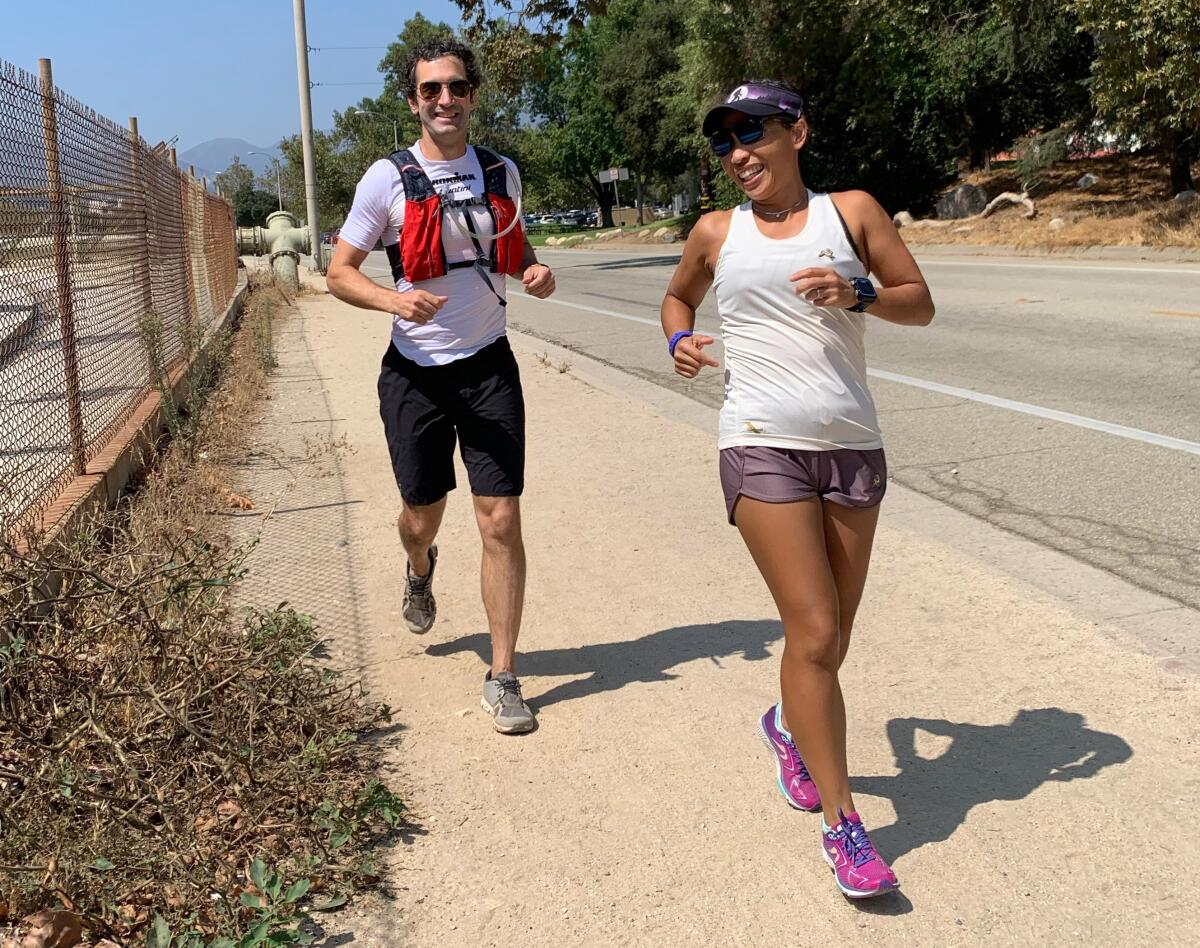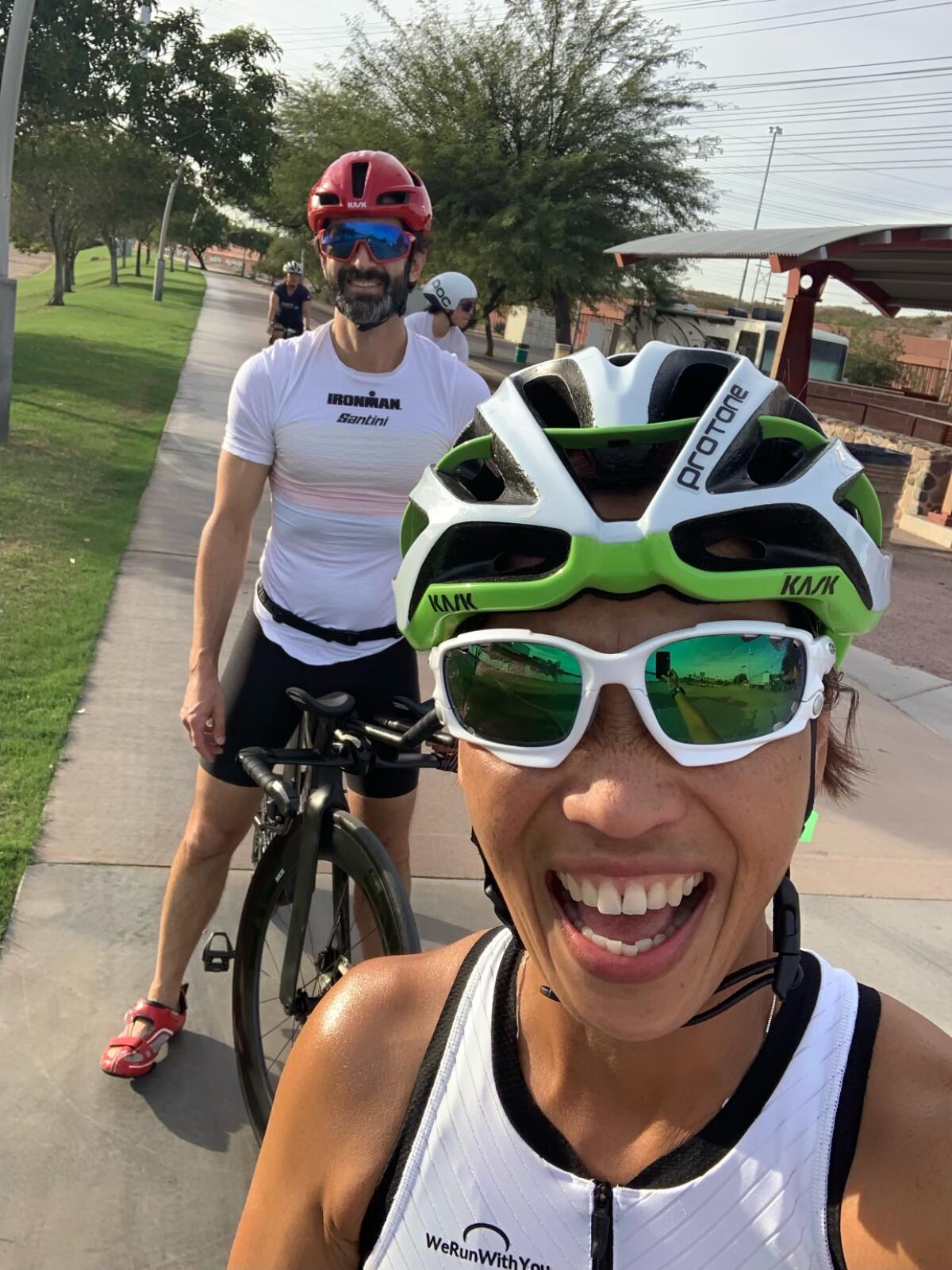In 2015, her life was in his hands. Now doctor and patient will run L.A. Marathon together

- Share via
Thousands of runners from around the world will line up Sunday for the 37th Los Angeles Marathon, but no two will have a story like Kathy Nguyen and Dr. Jonathan Russin, who plan to run together.
Seven years ago, Nguyen was 40, a wife, a mom, a long-distance runner — the last of nine children who fled Vietnam with their parents under harrowing circumstances after the war. There was no warning of what was to come in March 2015, other than the splitting headache she woke up with.
At a family brunch in West Covina, Nguyen collapsed, slumped against her sister, and was rushed to the hospital. Doctors were baffled at first and called in a neurosurgeon. He drilled a hole into her skull to relieve pressure caused by bleeding. A brain aneurysm had ruptured, and her chance of survival was not great.
Nguyen was in a coma when she arrived at Keck Hospital of USC, where two neurosurgeons — Russin and Dr. William Mack — studied scans of her brain.
The prognosis was grim.
In most cases, a ruptured aneurysm in the brain is treated by running a tiny platinum coil through an artery in the wrist or groin, all the way up to the damaged vessel. The coil then unravels and the aneurysm clots. If all goes well.
But Nguyen’s condition was not typical. She had a broad bulge that’s called a fusiform aneurysm, and a coil wouldn’t fix the rupture. Russin would have to open her brain and build a bypass around the aneurysm — a risky procedure. Russin explained the situation to Nguyen’s husband, Rob Alvarez, and laid out the risks of surgery.
And what were they?
“Death, coma, stroke, paralysis, bleeding, infections,” Russin said. “When I gave Rob the plan, he said, ‘How many of these have you done?’ I said, ‘A handful.’”
Back then, Russin was in his late 30s and helping to launch a bypass program. In the time since, he and his colleagues have performed hundreds of similar surgeries, and the Keck team has become one of the nation’s leading referral centers for the most complex cerebrovascular cases.

Nguyen was one of the early patients, and Russin knew that even if surgery was successful, the bleeding she had already experienced could cause lasting complications. But if they didn’t try, Russin told Alvarez, his wife had a 50% chance of another rupture within six months.
Nguyen and Alvarez both attended UC Santa Barbara. She became an administrator for a Bay Area candy company after college, and later worked in real estate in Delaware after Alvarez took a job as a chemical plant manager there. Their son and daughter, twins, were not quite 10 when her aneurysm ruptured.
Alvarez trusted his wife’s fate to the medical team.
The surgery performed by Russin took about six hours. Then Mack performed a secondary operation that took three or four hours.
Several days later, all signs were positive. In the weeks of recovery that followed, finding the strength to get from her bed to the bathroom was an ordeal for Nguyen. But she gradually became herself again.
So much so that she ran a mile in May, then more, and more, and more. She’d hated running as a kid, but it had become an obsession for her as an adult, and she’d even competed in a triathlon.
In the fall of 2015, she told her husband she wanted to run another marathon. He suggested she consider a much shorter run, maybe a 5K, but that’s not who Nguyen is.
“I think big,” she said, a trait she picked up from her father, who masterfully plotted the family’s escape from Vietnam, first to Malaysia, and then to the U.S. in 1979, when Nguyen was 5. In their first attempted flight, they’d been turned back at sea. Shots were fired, and Nguyen has a scar from the bullet that grazed her head.
Lopez: This 101-year-old surgical pioneer still works every day. And he’s not about to retire
Surgeon and mentor Dr. George Berci of Cedars Sinai is 101 but says his work is not done.
It would be great, she thought late in 2015, if she could run the L.A. Marathon in 2016 to celebrate her return to full health just one year after her surgery. So she stepped up her training, and she invited Russin and others affiliated with the USC Neuro Revascularization Center to run the last mile or two with her.
Russin, a college lacrosse player, was not a runner. But he took up Nguyen’s challenge, though not on her terms.
“He said, ‘I’m going to run the whole thing,’” Nguyen recalls. “I think Dr. Russin and I are cut from the same cloth.”
She doubted whether, given the doctor’s demanding schedule, he’d have the time to train. On the day of the race, they couldn’t find each other in the sea of runners, so they began separately. At the 20-mile mark, Russin hit a wall. He stopped to rest and called Nguyen by cell.
She answered and said she was coming up behind him. He waited, found his second wind, and ran the rest of the race, holding Nguyen’s hand part of the way.
Since then, Russin has caught the bug. He and Nguyen did a triathlon last year in Arizona. On Sunday, they will run their sixth L.A. Marathon together. Nguyen has dedicated herself to running for a cause — raising awareness about aneurysms and raising money, through sponsors, for medical research.
In the L.A. Marathon, and in the upcoming Boston Marathon — for which she’s already qualified — she’ll be running for a nonprofit she and Alvarez have established to support brain aneurysm survivors and their families called We Run with You. Both donors and runners can find out more about supporting the cause at https://charity.pledgeit.org/WeRunWithYou.
Roughly half a million people in the world die each year of ruptured aneurysms. In the U.S., an estimated 6.5 million people have unruptured aneurysms, meaning the bulge is there, but the walls of the blood vessel are holding. About 30,000 people a year in the U.S. suffer a life-threatening rupture. Women are more likely victims than men, and Black and Latino people are twice as likely to experience a ruptured aneurysm.
“When they burst,” Russin said, half the people die at the time of the rupture or shortly thereafter. “Of the half who survive, half of them will never be functionally independent again.” Many of those who make it suffer bouts of depression, he said, shaken by the sudden discovery of their own mortality, and many experience survivors’ guilt.
Although ruptures generally occur without warning, Russin said, smoking and hypertension are risk factors. And anyone with family members who have had aneurysms should talk to a primary care physician about getting a brain scan, Russin said.
As a child, Nguyen and her family ran for a better life. Three weeks ago, her brother, the second-eldest of the nine siblings, died of cancer.
Nguyen said she’ll be running for him, and for her father, who died in 2017.
And for thousands of others.
Steve.lopez@latimes.com
More to Read
Sign up for Essential California
The most important California stories and recommendations in your inbox every morning.
You may occasionally receive promotional content from the Los Angeles Times.












